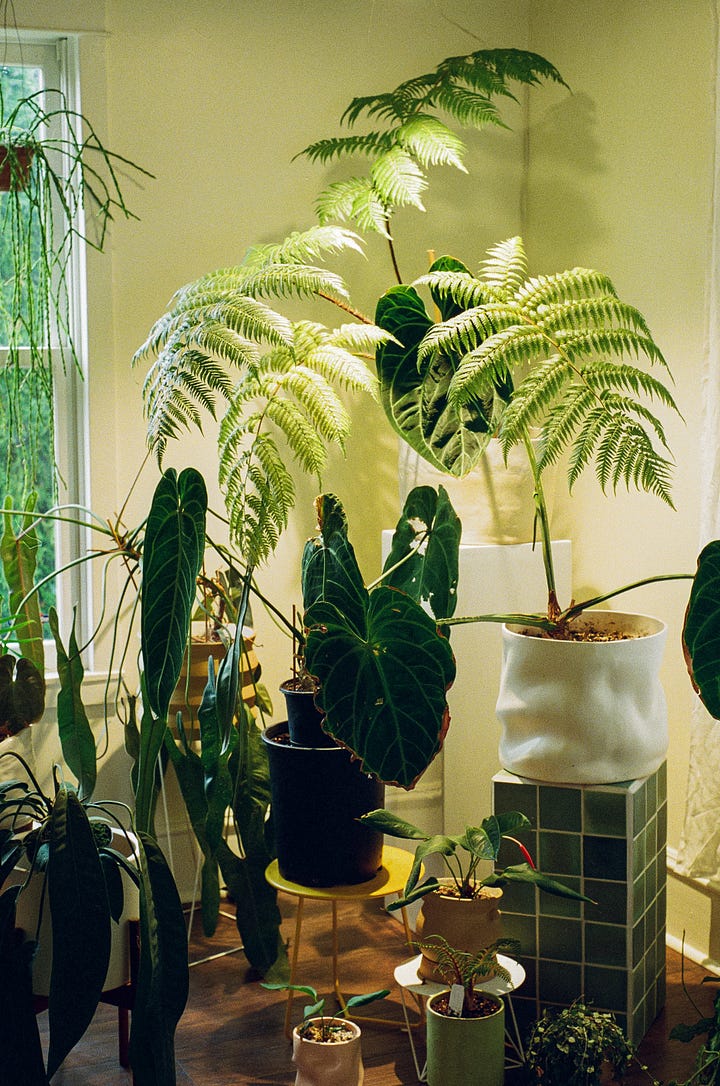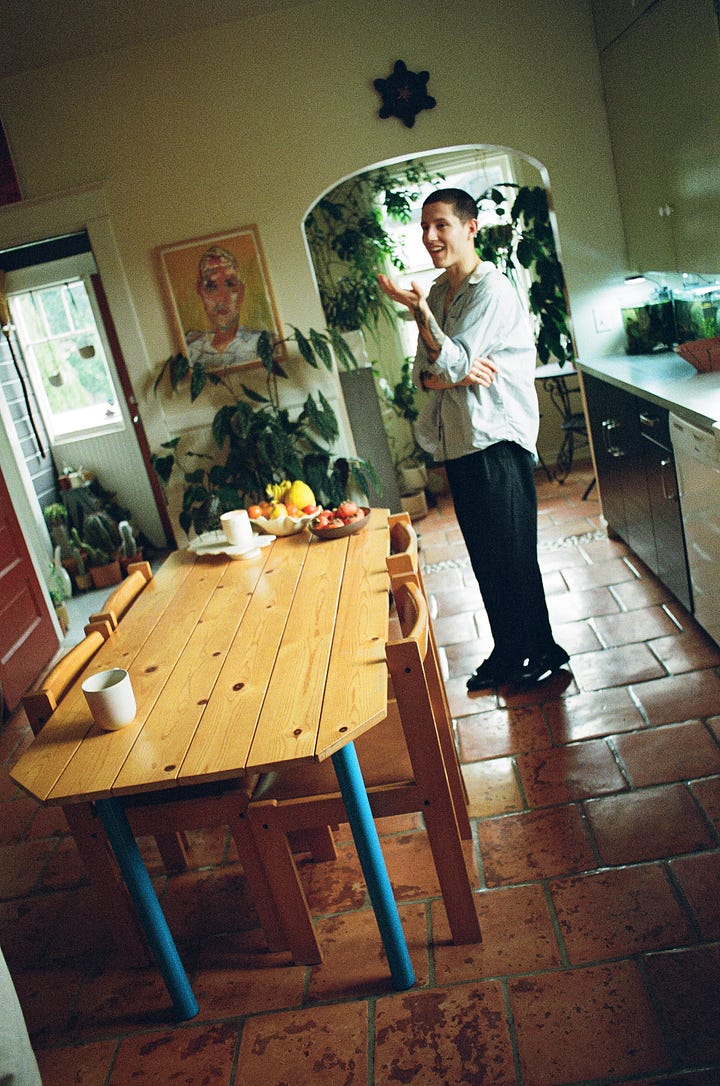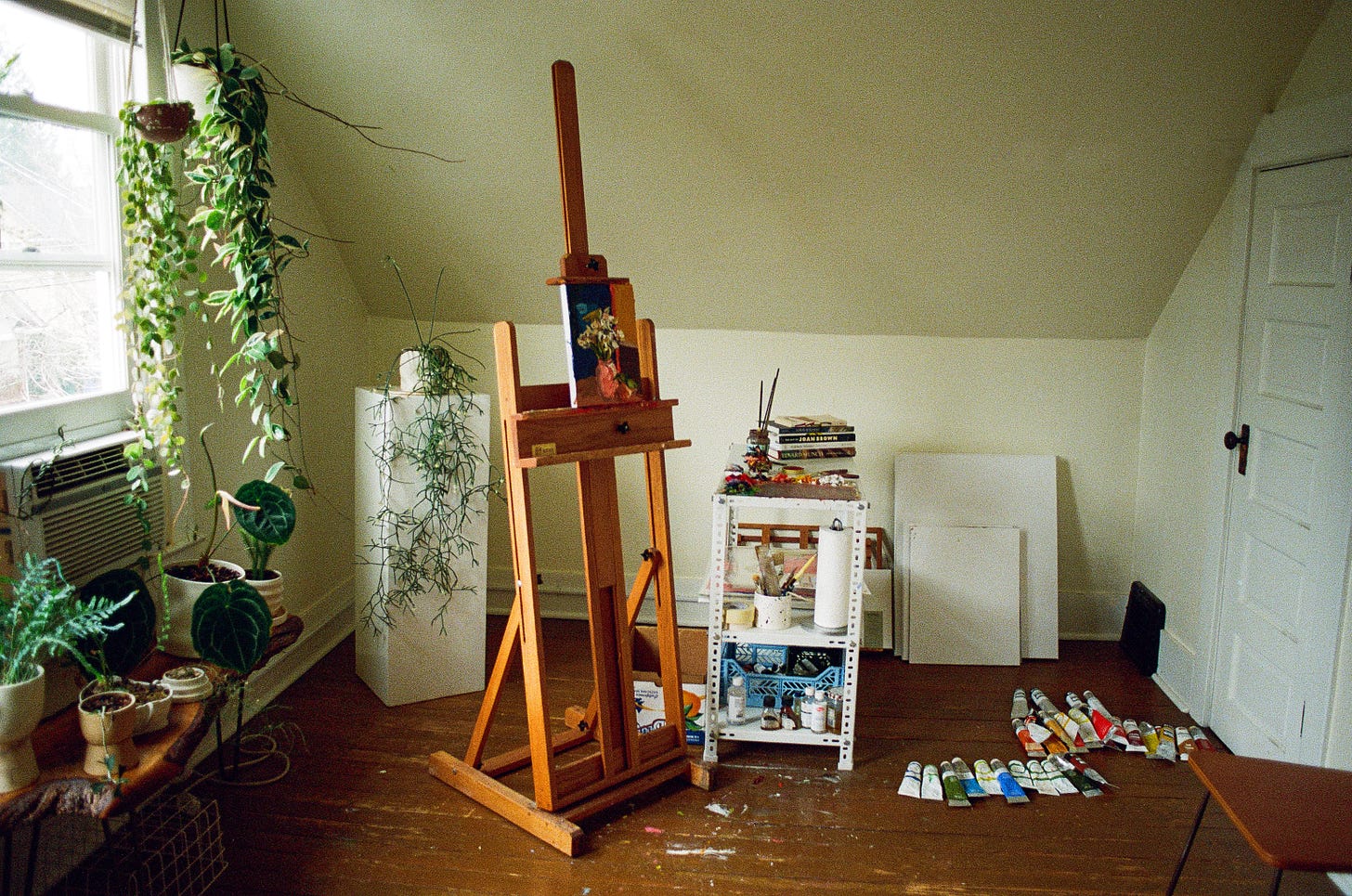Studio visit with Tylor Rogers
Channeling his observations and love of living things into thick, quick strokes of oil paint

In the very back of Tylor Rogers’ Northeast home is a tiny room off the kitchen. Plants sit in pots on the terracotta tiles and hang from the ceiling over iron patio chairs and a matching table. It’s giving Italian terrace in summertime and looks like the perfect spot to enjoy morning coffee and sunlight—but then, so do all the other nooks in the rest of the house, from the living room with the mustard-yellow velvet couch to the second-floor studio that smells faintly of oil paints.
You might know Tylor first and foremost as one of the owners of Arium Botanicals, a terrarium-like garden center off MLK Boulevard. He and his parter, Alba, opened online almost seven years ago when they were still living in Indiana to share their curiosity and excitement for botany, horticulture, and rare plants. Their most precious rescue pup from Mexico is even named Tulip.
But this year, Tylor made his public debut as an oil painter, an identity he’s held far longer even than that of “plant shop guy.” By following his interest in all types of art, he has sort of created his own genre of painting, neither impressionist nor figurative, that’s marked by quick but thoughtful brush strokes, thick layers of paint, and bold and saturated colors. From a distance, his paintings appear as fully-formed portraits and figures and still-life scenes. “My passion for plants and living things is still the foundation of what I do,” he says. Up close, the texture becomes more abstract and looks delicious enough to eat, like frosting on a cake.
Now through January 17, you can find Tylor’s artwork on view at The Hoxton.
What has your creative journey been up to this point?
From literally the moment I was born, I felt like I couldn’t hold a traditional office job or fit into what was expected of me professionally. There was a lot of frustration in that especially with parents and leadership being like, you have to go to college, you have to check these boxes. I have so many interests and I want to pursue them all, but how does that translate into an actual career and pay my bills? I ended up going to college. I was initially in school to be a physicians assistant. A totally different world and realm of painter and plant shop owner. In school, I took a few painting classes, and I had a really wonderful teacher in advanced oil painting. Everyone was so fantastic and I remember feeling almost a little bit of imposter syndrome. My work looked totally different than what everyone else was doing. We focused a lot on the figure in college. My interpretations of the figure would be a big streak of yellow for the leg, a big streak of red with some tonal highlights for the chest, in comparison to my peers who were painting details with a very thin paintbrush. What really hit home one day is when my teacher pulled me aside and she was like, you really have something going for you. She’s like, you should keep at it. She suggested a few figure drawing classes and technical courses. It was the validation that I needed.
You seem very studious of the craft. I’m wondering how you create that curriculum for yourself.
I am a dedicated student to artist documentaries. I’m obsessed with them, whether it be Bay Area painters or New York painters or an artist I see in a book that I want to learn more about. I feel like I’ve put myself through fake art school because every time I’m upstairs in that room, there’s some type of audio by an artist, whether it be about their practice or history. It’s another one of those things I didn’t realize I was doing until Alba was one day like, you are cycling through these artists and taking it all in. I think you can pick up a little bit from everyone and be inspired by them, and it lives with you whether you know it or not. It’s been really fun to immerse myself into the lives of other creatives.
What does studying other artists provide for you?
A constant source of learning. As we look through some of my older paintings to where I’m at now, it doesn’t look the same. I’m so happy to not be confined to a category, like impressionist or figurative. There’s always going to be outside influences or new information to take in. My iterations of my paintings are all just reflections of me and my lived experiences. As I’m learning new things, it’s nice to see it translated into my actual work as well.
When inspiration strikes, what does it feel like? And then how do you arrange your day in order to create?
When inspiration strikes, it’s all encompassing. I cannot think of anything else. It almost feels like a compulsion of I have to do this. I have to get it out otherwise it’s going to be all consuming. I’ve heard so many painters say they get into a flow state and forget to eat lunch and dinner. It’s hard to fully believe until you experience it. I fall into that stereotype. During a busier part of life, I would wake up early just so I could paint for three hours uninterrupted. Then I would come home and cancel plans to paint. I think I’m at a point where I can finally lean into it and allow myself to be dedicated to it.
One of my favorite practices here in the studio is timed sketches. Do you remember in elementary school when you would do the times tables? I was addicted to that feeling of hurrying up. I looked forward to those multiplication tests. I’m able to translate that pressure into my practice. I set five minutes on the clock and try to paint until the timer stops. Recently what has transpired is minute paintings that I then translate into larger paintings.




I have to ask. What is this glob of paint on your palette?
(See photo above in the upper right corner.)
I call them collaborations. It’s really wholesome to me to realize this little slop of paint has seen every iteration of one of the paintings on the wall. I can recognize certain colors in it from being from certain paintings. The last few shows, I’ve hung up this glob on the wall. People love it. It was the first piece to sell. It’s really sweet to know that it spoke to someone; they get all of the paintings in one.
I feel like artists are sometimes hesitant to display their own work, so I just love that you have your own paintings in your house.
I want to surround myself with handmade objects. Things that people in my life have made. I think that translates really nicely into this idea that a painting can be living on your wall that you made or a friend made, and it’s observing your day-to-day life. It is a silent object, a fly on the wall. It’s seeing you at your happiest. It’s seeing you come home when you’re upset. It’s there to watch you when you’re cooking dinner. The objects you surround yourself with are an active participant in your life.
Why oil: “The smell of it helps. I feel like it chemically has me hooked. Also I love good texture to a painting and you can really only achieve that with oil.”
Something you want to paint that you haven’t painted yet: “I want to start painting mainly figurative pieces that feel like you can step into them. Ideally they’d be 12 feet. I just don’t have space to do it at the moment.”
Painters you admire: “The Bay Area’s figurative painters, like Joan Brown, Elmer Bischoff, and David Park. If you look at some of their paintings, it’s not traditional portraiture or realistic portraits of people. As for living artists, Jennifer Pochinski and Emilio Villalba.”
Simple pleasures lately: “Citrus. I look forward to this time of year for the in-season fruit.”
How you like to spend time with Alba: “Two answers. My favorite thing is just going on long walks together. It’s a very simple joy we can access every day. Second, it feels really fun being two artists living together. In our basement, she has a full ceramics studio.”
A plant worth sharing about: “Anthurium scherzerianum. When it blooms, it has a little pigtail. It’s like the eighth wonder of the world. Nobody really knows why it spirals on itself.”


You’ve just started showing your work this year, right?
I’ve been a painting recluse for years. Only my family has my paintings from college. I’ve never shared photographs of them or parted with any of those pieces. I took a little bit of a break from painting after college but once I started up again, I still didn’t feel confident in those paintings so they’re just piled away as part of the process. Those, I think, led me up to this point. I realized I want to see my pieces out in the world. Last year, The Hoxton put out an artist call when they were starting their gallery. I applied with having no show experience. Initially they said no. I was like, at least I tried. A few months later, I had a show with Wilma. It ended up being almost fully sold out. A week after that, The Hoxton reached back out. Then Maps asked me if I wanted to show some pieces there. The tides have turned. While I’m still very new to publicly showing my work, I’m happy to finally be at this point. Thankfully it’s been really well received.
How might someone enter Portland’s art scene or community if they’re not already familiar or connected?
I think the best way to enter one of those communities is to be an active participant in it. If I wanted to find myself amongst the painters, I would go to as many painting shows as I could to celebrate the other painters and partake in their joys and successes. From there, you’re going to meet other people, and it’s naturally going to come up that you’re also a painter. You can spark so many fantastic relationships with that. Same within the plant world. It’s never in a competitive sense. Maybe that’s the nice thing about Portland. We can all be active participants without feeling like we have to one-up each other.
Where you can find Tylor | Instagram | Arium Botanicals
Amelia Arvesen (she/her) is the creator of Honing Her Craft and a freelance journalist who integrates her artistic side into her every day. The STUDIO VISITS series merges her curiosity as an interviewer with her admiration of creative practices, people, and spaces.
Lauren Beane (she/her) is a freelance photographer specializing in film. She values a life centered around art, nature, community, and little pleasures. This series allows her to expand her definition of what it means to live a creative, artful life while providing others a window to do the same.
You can find previous editions of STUDIO VISITS here. Support this series by liking it, forwarding it, or upgrading to a paid subscription. Thanks for reading!







seeing someone else with a studio in a spare room (fumes be damned!) surrounded by beloved objects (the Trader Joe's tahini jar!) made me feel so seen. love this interview
Love how bright the studio feels and I’m lol at the paint glob 😝